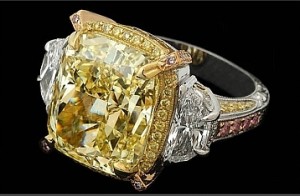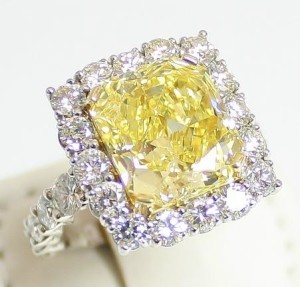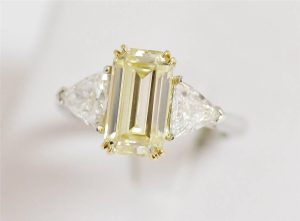 When most of us think about diamonds, we tend to think of the classic round brilliant engagement ring–a nearly flawless, perfectly clear stone that returns light to the eye with flashes of fire and brilliance.
When most of us think about diamonds, we tend to think of the classic round brilliant engagement ring–a nearly flawless, perfectly clear stone that returns light to the eye with flashes of fire and brilliance.
The vast majority of diamonds fall into this category, and while some of these can exhibit slight colorings of yellow and brown, nature does occasionally produce diamonds of colors all across the spectrum.
The geologic conditions required to produce these stones are quite rare, making diamonds with naturally occurring colors highly coveted. Experts estimate that only one out of every 10,000 diamonds mined is a colored diamond.
Although colored diamonds have been around forever, their popularity is a fairly recent phenomenon. Thanks in part to a marketing campaign by the Argyle mine in Australia in the 1980s that highlighted trade names like “Champagne” and “Cognac,” the public became more aware of colored diamonds, and their popularity has continued to grow.
What is a Colored Diamond?
Color, along with clarity, cut, and carat weight, is one of the ‘Four Cs’ used in judging diamond quality. When grading most diamonds, color actually refers to the absence of color. Pure or nearly pure diamonds are transparent and colorless, and are graded on a scale from D (colorless) to Z (light yellow). Most diamonds will have tints of yellow or brown, but diamonds that exhibit more brown or yellow color than the Z grade, and diamonds of any other colors, are considered fancy-colored diamonds.
How are Fancy Diamonds Made?
 Diamonds are made up of mostly carbon atoms, and were formed about 100 miles beneath the earth’s surface literally billions of years ago. Under intense pressure and high temperature, carbon atoms bonded together to form diamond crystals, and were transported quickly to the earth’s surface by ancient volcanic activity. The crystals cooled quickly, locking the carbon atoms into the diamonds we admire today.
Diamonds are made up of mostly carbon atoms, and were formed about 100 miles beneath the earth’s surface literally billions of years ago. Under intense pressure and high temperature, carbon atoms bonded together to form diamond crystals, and were transported quickly to the earth’s surface by ancient volcanic activity. The crystals cooled quickly, locking the carbon atoms into the diamonds we admire today.
A theoretically ‘perfect’ diamond would be made of only of perfectly crystallized carbon atoms, but that diamond exists only in theory. Most diamonds have some impurity or defect, some of which can give rise to color in the stone.
The most common impurity in diamonds is nitrogen, which produces a diamond with a yellow to brown hue. These diamonds are generally graded low on the color scale unless there is enough nitrogen present to merit a ‘fancy-color’ diamond designation.
In some cases the nitrogen atoms are arranged in a specific way that absorbs light in the blue and yellow part of the spectrum, producing an orange diamond. Orange diamonds may contain brown, yellow, or pinkish modifying colors.
Blue diamonds are very rare, with about one in 200,000 diamonds exhibiting a blue hue, and even then, it is typically a very pale blue. A bit of boron bonded to the carbon causes absorption of the red, yellow, and green parts of the spectrum, producing a blue color. Blue diamonds often have gray, greenish, or violet modifying colors.
Pink diamonds are formed by mechanical stresses on the crystal structure as the the diamond travels to the surface of the earth. The resulting defects trap electrons in such a way as to interact with light to produce pink and red colors. The deepest reds are the rarest diamonds of all, and sell for the highest price per carat of any gem.
Green diamonds are formed after the stone makes its trip to the surface of the earth by naturally occurring radiation in the rocks where the diamonds are found. The radiation causes defects that trap electrons in the crystal, interacting with light in a way that produces the green color. The green color is usually only at the surface of the diamond, and rarely throughout the diamond, making intensely green diamonds exceptionally rare.
Colored Diamonds: Synthetic and Treated
Fancy-color diamonds can be produced artificially in a wide range of colors, and while potentially cost effective, they are generally less desired and therefore less valuable than naturally occurring colored diamonds. Natural diamonds can also be treated by high pressure and high temperatures to produce or enhance color, and some diamonds are actually irradiated to produce color.
Treated and irradiated diamonds can exhibit intense colors, but should always be identified as such. The grading report on any colored diamond should indicate not only the quality of the diamond, but the origin of its color as well.
How Are Fancy-Color Diamonds Graded?
 Fancy-color diamonds are graded using the same comprehensive 4 Cs parameters as white diamonds, but they are evaluated more for their color intensity than their fire or brilliance.
Fancy-color diamonds are graded using the same comprehensive 4 Cs parameters as white diamonds, but they are evaluated more for their color intensity than their fire or brilliance.
Laboratory specialists grade fancy-colors from the face-up, or top view of the diamond, and describe the colors in terms of hue (a diamond’s overall body of color), tone (color’s relative lightness or darkness), and saturation (the intensity or degree of color).
Deep and distinct shades are rated more highly than weak or pale ones. A color’s “strength” is indicated by a saturation-tone grade, from Light to Dark, Intense, Deep, and finally Vivid.
Grading fancy diamond color is complicated. Diamonds can appear to have a single hue, or they may have a secondary or even a third color. The designation “purple pink” would indicate that pink and purple hues are virtually even throughout the diamond. “Fancy greenish-brownish-orange” would indicate that orange is the primary hue, with green and brown the secondary hues. Panels of experts use master stones as a reference and highly controlled viewing conditions when determining color, but the final color designation is ultimately subjective.
While the clarity of fancy-color diamonds is evaluated in the same way as it is with white diamonds (with inclusions and blemishes carefully described and mapped), clarity is less important in fancy-color diamonds. The rarity of color is a bigger factor than clarity in determining the diamond’s value. In fact, some colors naturally have more inclusions than others, and sometimes the color of the diamond itself can mask the inclusions, making a stone graded SI1-SI2 (slight inclusions) appear “eye clean,” or flawless, to the naked eye.
The way fancy-color diamonds are cut is also a bit different from white diamonds. Although the same methods are employed and the same shapes are crafted, fancy-color diamonds are shaped to maximize color rather than fire or brilliance. The cut can actually affect the color–for example, changing the angles on the pavilion or crown of a stone can greatly increase the strength of color.
Proportions considered ideal for white, colorless diamonds simply do not apply to fancy-color diamonds. And certain shapes can help enhance particular colors. Yellow diamonds are often fashioned into radiant cuts, as this particular shape enhances the yellow hue.
———
Los Angeles Jewelry Buyer purchases all types of rare, naturally-occurring, fancy-colored diamonds and diamond jewelry. Contact us today for a Los Angeles diamond appraisal and immediate cash offer for your large carat fancy-colored diamond rings, necklaces, and earrings.